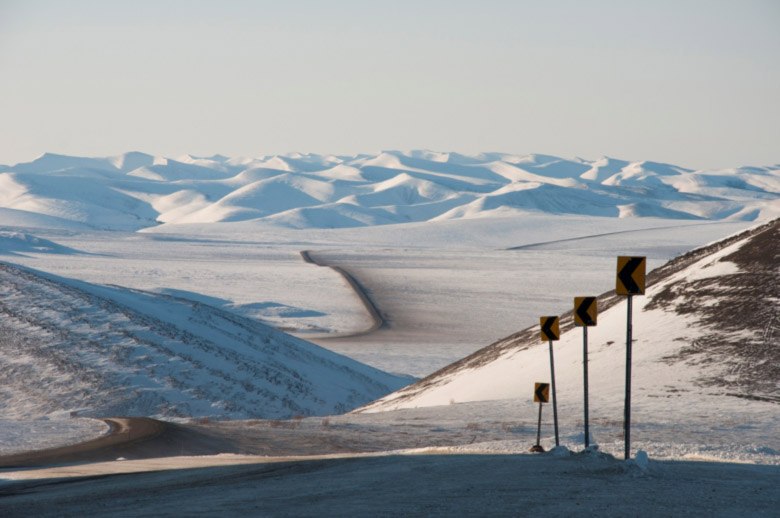Dempster Highway infrastructure impacts local permafrost conditions
Author: Olivia Mussells – MSc. Candidate, University of Ottawa

The Dempster Highway near the Yukon-NWT border. Photo: Brendan O'Neill
Summary
- The Dempster Highway is an important transportation route for northern communities in the Yukon and Northwest Territories (NWT). The highway embankment and snow fences along the portion of the Dempster Highway located in the Peel Plateau, NWT region have altered nearby snow accumulation patterns, which can impact the active layer thickness above the underlying permafrost.
- Researchers from Carleton University, in partnership with the Northwest Territories Geological Survey, Tetlit Gwich’in, Transport Canada, Government of Northwest Territories’ Department of Transportation and the Aurora Research Institute, have been monitoring permafrost conditions along the snow fences and embankments of the portion of the Dempster Highway located in the Peel Plateau, NWT region since 2012.
- Results demonstrate that the embankments and snow fences along the Dempster Highway increase snow accumulation, resulting in permafrost warming and degradation. Degraded permafrost causes the ground to sink, which may promote pooling of water and damage to the road, as well as a shift to more moisture-tolerant vegetation cover.
- Monitoring the impacts of snow fences and embankments along the Dempster Highway on local permafrost conditions is important for predicting future road maintenance costs and informing the development of adaptive measures. These findings should be considered when planning future northern transportation infrastructure projects in order to minimize negative impacts on permafrost and damage to infrastructure.
Context
The Dempster Highway is an important transportation route for northern communities in the Yukon and Northwest Territories (NWT), facilitating the receipt of services and supplies from southern Canada2. The all-weather, gravel highway is primarily built above continuous permafrost, which is susceptible to degradation if soil temperatures warm. Active layer thickness is highly influenced by both air temperatures and snow cover depth, given that snow insulates the ground and prevents heat loss4. Warming ground temperatures can cause the active layer to thicken and the underlying permafrost layer to degrade over time5.
To reduce snowdrift, snow fences were constructed alongside portions of the Dempster Highway in the 1980s. The snow fences have increased snow accumulation in the area and altered the underlying permafrost layer1,2 .
Since 2012, researchers from the Department of Geography and Environmental Studies at Carleton University, as well as the Northwest Territories Geological Survey, Tetlit Gwich’in, Transport Canada, Government of Northwest Territories’ Department of Transportation and the Aurora Research Institute have been studying permafrost degradation along the portion of the Dempster Highway located in the Peel Plateau, NWT region with annual field visits.
Results & Implications
Based on research since 2012, road embankments along the Dempster Highway can trap snow and water, which slows the cooling of the ground over the winter2. At all but one site, annual ground temperatures along the Dempster Highway embankments were 0.5 to 2.5°C higher than those taken at control sites, and had thicker active layers 2. This corresponded with thicker snow packs at the sites along the highway embankments where snow depths of up to 2.2 m were measured compared to 0.4 to 0.8 m at the control sites2.
In addition, along snow fences on flat terrain in the Peel Plateau region of the Dempster Highway:
- The active layer thickness increased compared to control sites as a result of greater snow accumulation and ground warming.
- Subsidence, or sinking of the ground, also occurred, causing moisture to collect and the ground to become saturated. This led to a shift towards moisture-tolerant vegetation1.
- There was no observed change along snow fences on sloping terrain1.
Policy Linkages
- Understanding how the road embankment and snow fences degrade permafrost and damage roadways can aide transportation managers with the Government of the Northwest Territories in planning budgetary expenditures for future road maintenance. These findings also indicate the need for further adaptive road construction and maintenance measures in the North, and could inform the further development of these techniques and technologies.
- These results should be considered when planning future highway development in permafrost regions. For example, placing snow fences on well-drained, sloping areas could prevent permafrost degradation associated with increased snow accumulation.
References
1 O’Neill, H.B., Burn, C.R. (2015). Permafrost degradation adjacent to snow fences along the Dempster Highway, Peel Plateau, NWT. Proceedings from Conference: GEOQuébec 2015, Quebec City, Quebec: Canadian Geotechnical Society and Canadian National Committee for the International Permafrost Association.
2 O’Neill, H.B., Burn, C.R., Kokelj, S.V. (2015). Field measurements of permafrost conditions beside the Dempster Highway embankment, Peel Plateau, NWT. Proceedings from Conference: GEOQuébec 2015, Quebec City, Quebec: Canadian Geotechnical Society and Canadian National Committee for the International Permafrost Association.
3 Burn, C.R., and Kokelj, S.V. (2009). The environment and permafrost of the Mackenzie Delta area, Permafrost and Periglacial Processes, 20: 83-105.
4 Zhang, T. (2005). Influence of the seasonal snow cover on the ground thermal regime: an overview, Reviews of Geophysics, 43: 1-23.
5 Burn, C.R., Mackay, J.R., and Kokelj, S.V. (2009). The thermal regime of permafrost and its susceptibility to degradation in upland terrain near Inuvik, N.W.T., Permafrost and Periglacial Processes, 20: 221-227.